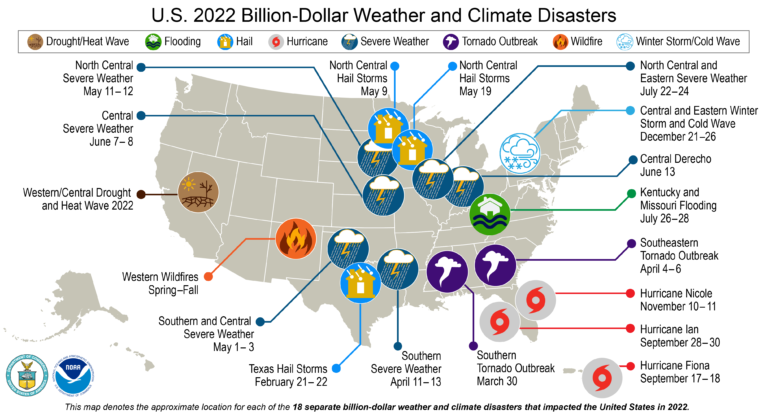Record drought gripped much of the US in 2022 with many states experiencing extended duration and coverage, according to the National Oceanic and Atmospheric Administration’s (NOAA) latest analysis.
The average annual temperature across the contiguous US was 53.4°F (11.9°C), 1.4°F above the 20th-century average – ranking it in the warmest third of the 128-year record.
Florida and Rhode Island both saw their fifth-warmest calendar year on record while Massachusetts ranked sixth warmest. Four additional states experienced a top-10 warmest year on record – California, Connecticut, Maine and New Hampshire. Alaska saw its 16th-warmest year in the 98-year record for the state.
Annual precipitation across the contiguous US totaled 28.35in (72cm) – 1.59in (4cm) below average; this placed 2022 in the driest third of the climate record. Nebraska saw its fourth-driest year on record while California had its ninth driest. Meanwhile, above-average precipitation caused Alaska to have its fourth-wettest year on record.
Drought coverage across the contiguous US remained significant for the second year in a row, with a minimum extent of 44% occurring on September 6 and a maximum coverage of 63% on October 25 – the largest contiguous US footprint since the drought of 2012.
In the western US, drought conditions reached a peak coverage of 91.3% of the region on May 3. Drought coverage across the West shrank as the summer monsoon reduced some of the coverage in the Southwest. The multi-year western US drought resulted in water stress/shortages across many locations in 2022 as some major reservoirs dropped to their lowest levels on record.
Billion-dollar disasters in 2022
Last year, the US experienced 18 separate billion-dollar weather and climate disasters, leading to the deaths of at least 474 people. This tied 2022 in third place (with 2011 and 2017) for the highest number of disasters recorded in a calendar year, behind 2021 with 20 events, and 2020 with a record 22 separate billion-dollar events.
Damages from these disasters totaled approximately US$165bn for all 18 events. This surpasses 2021 (US$155.3bn, inflation adjusted) in total costs, which makes 2022 the third most costly year on record, only behind 2017 and 2005 (all inflation adjusted to 2022 dollars).
Hurricane Ian was the most costly event of 2022 at US$112.9bn, and ranks as the third most costly hurricane on record (since 1980) for the US, behind Hurricane Katrina (2005) and Hurricane Harvey (2017).
Over the last seven years (2016-2022), 122 separate billion-dollar disasters have killed at least 5,000 people, with a total cost of more than US$1tn in damages. Five of the last six years (2017-2022, with 2019 being the exception) have each had a price tag of at least US$100bn.
Other notable climate and weather events in 2022
An average but destructive hurricane season: during 2022, 14 named storms formed in the North Atlantic Basin (four tropical storms, eight hurricanes and two major hurricanes), which is near the historical average. Several notable storms brought destruction and flooding to portions of the US.
Hurricane Fiona brought massive flooding to Puerto Rico, with some areas receiving 12-18in (30.5-45.7cm) of rain. Hurricane Ian, with 150mph (241km) sustained winds, made landfall in southwest Florida, resulting in major flooding, damage and loss of life. Later in the year, Hurricane Nicole made landfall along Florida’s eastern shore, flooding the coast and knocking out power for hundreds of thousands of people. Nicole was the first hurricane to hit the US during November in nearly 40 years.
An above-average tornado year: the preliminary US tornado count for 2022 was approximately 9% above the 1991-2020 average across the contiguous US, with 1,331 tornadoes reported. March 2022 had triple the average number of tornadoes reported (293) and the most tornadoes reported for any March in the 1950-2022 record.
Wildfires scorched the West and Alaska: in addition to the active wildfire year across the western US, Alaska saw 1,000,000 acres (404,685ha) burned by June 18 – the earliest such occurrence in a calendar year than any other time in the last 32 years. By July 1, 1,850,000 acres (748,669ha) had been consumed – the second-highest June total on record and the seventh-highest acreage burned for any calendar month on record for Alaska.



